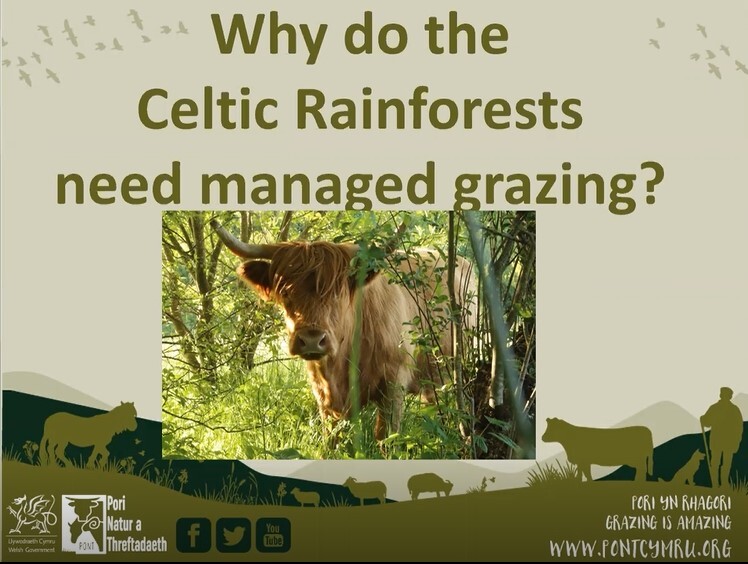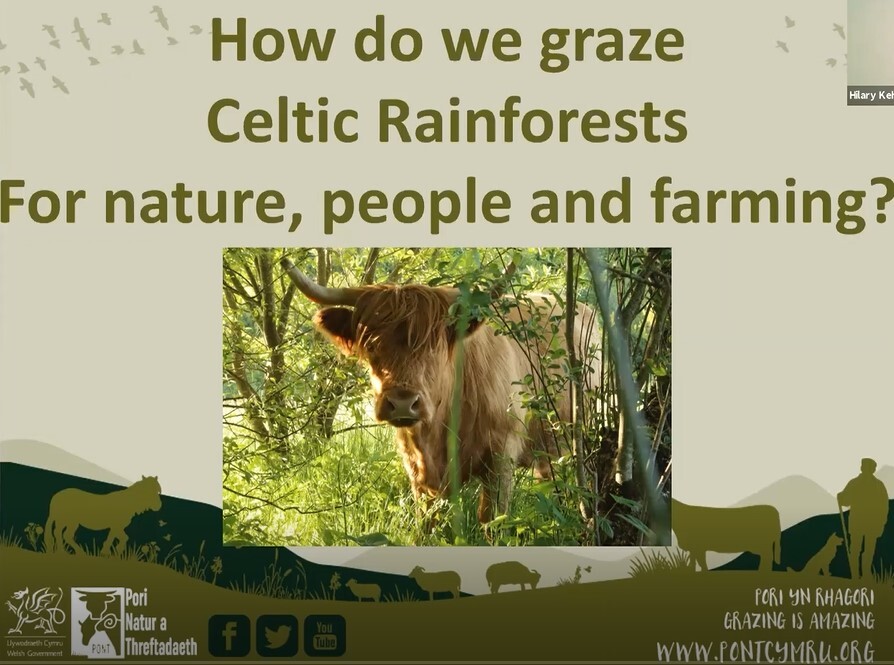Conservation Grazing

Downloads
| Grazing in a Celtic Rainforest - A Guide for Woodland Managers | Open |
| Conservation Grazing Case Study: Coed Crafnant | Open |
| Conservation Grazing Case Study: Coed Garth Gell | Open |
| Conservation Grazing Case Study: Abergwynant y Gribin | Open |
| Conservation Grazing Case Study Coed Lan fraith | Open |
Conservation Grazing
Our native woodlands have a long history of grazing, either by wild animals or domesticated livestock, and this has led to the development of many of our most valuable habitats. However, in the more recent past, livestock numbers increased and many areas were becoming overgrazed. Some sites, particularly those with ecological designations, were fenced off in order to exclude grazing animals. This was particularly true with woodlands, where browsing was seen to be detrimental to young trees. Over time, this lack of grazing had undesirable impacts on woodland ecosystems, namely an increase in the abundance of bramble, ivy and other species commonly found in the understorey. Whilst a small amount of bramble and ivy makes a fantastic habitat and food source, and our woods need saplings to be the mature trees of the future, too many of these can be detrimental to associated ground flora including the precious lichens and bryophytes of the Celtic Rainforests.
It is now widely acknowledged that conservation grazing is a very effective tool in managing native woodland habitats. A herd or flock of grazers can produce the desirable variation in habitat structure, either directly by grazing, or by moving around a site.
It is really important to select the right type of animal for a site – you’d be surprised at how grazing characteristics differ from one animal to the next. For example, sheep will nibble carefully at their preferred delicacy, and native breeds will usually browse small saplings. They are light, nimble, and can access most areas. However, they are prone to getting their wool tangled in the brambles. On the other hand, cattle are heavier and able to push through thicker vegetation such as bracken and bramble. They feed by wrapping their tongues around a patch of vegetation and tearing it away. This leaves a much rougher structure behind – great for making an interesting habitat. They can also reach higher into trees to browse. Ponies lie somewhere between the two – they nibble, but they are large enough to have some impact on the physical structure of the site. Native breeds are usually preferred for conservation grazing as they have developed and thrived on rough food and are hardy enough for our weather. In addition to their ability to create variation in woodland habitats, the dung of livestock is in itself a food source for many invertebrates such as dung beetles, thus adding another benefit of having livestock within a woodland.
When sustainable stocking levels are surpassed, there are often tell-tale signs within a woodland such as the presence of damaged trees at grazing height, or the complete absence of young saplings. At the other extreme, where there is too little grazing, one will soon observe more aggressive plants such as bramble or bracken becoming dominant within a site. Both situations are undesirable, and that is why having a balanced grazing regime using the correct animals can increase habitat diversity.
In order for grazing to be sustainable in the long-term, the work must be both economically attractive and practical for the grazier. This requires the correct infrastructure to be in place, such as access tracks, stock-proof boundaries, adequate stock handling facilities, water supply and, where needed, sustainable support payments in order to make the continued management of the woodlands economically feasible. Consequently, if the conditions are right, the use of livestock as a sustainable conservation tool can assist both the ecology condition of the woodland, and bring socio-economic benefits to land managers.

Listen to our English webinar “Why do Celtic Rainforests need managed grazing?” that we presented live on 17.9.20 – our first video on our new project Youtube channel. Our first grazing webinar on YouTube

Listen to our English webinar “How we graze Celtic Rainforests for integrated farming and habitat restoration?” that we presented live on 24.9.20 – our second video on our new project Youtube channel. Our second grazing webinar on YouTube
Below is a link to see the presentation about conservation grazing we gave at the Wales Biodiversity Partnership conference 2020 . It includes footage from the RSPB site Coed Garth Gell and the National Trust site Dolmelynllyn, Ganllwyd.
Discover more about the conservation grazing element of the project by reading the case studies kindly prepared by members of the project team, Julia Harrison and Helen Upson.
Footer
For further details, enquires and comments please contact the Project Officers at
Telephone: 01766 770274
Email: post@celticrainforests.wales
Address:
Snowdonia National Park Authority,
National Park Office, Penrhyndeudraeth, Gwynedd. LL48 6LF
© 2019 - 2025 Celtic Rainforests Wales. All Rights Reserved
Subscribe to our Newsletter
